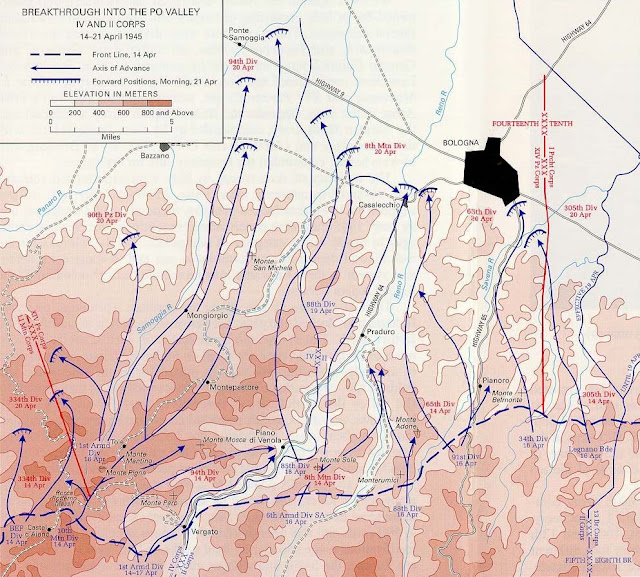On April 13, the receipt of orders signaled that the day of attack was imminent. This was confirmed by the constant presence of bombers flying north. Allied troops were urged to strike boldly and crush the German armies in Italy.
On April 14, the regiment was placed on a six-hour alert, but regular training continued. By late afternoon on April 16, orders arrived to move the regiment by motor to the vicinity of Sassomolare on April 17. The 60-mile journey was completed by midmorning. The plan involved relieving elements of the 10th Mountain Division in the newly assigned sector of the 85th Division and continuing the attack northward. Despite time constraints, trucks were requested to shuttle one battalion forward. The 1st Battalion headed to Cereglio upon receiving these trucks, while the remaining units marched to the same area.
Despite the challenging circumstances, Johnnie managed to write a letter to Lucile on April 17, 1945. In the letter, he subtly hinted at their future, suggesting the possibility of starting a family once he returned home.
My Dear Darling,
Just a few lines to let you know I am well and hope with all my heart that this finds you in the best of health. I received a letter from Happy yesterday. He seems to be OK, at least he seems perfect. He sent me a picture of his future wife. The way he wrote they are sure crazy about each other and he plans on marrying her as soon as he gets leave. He told me to be sure and send the picture back. By looking at the picture, she seems to me to be older than him. But you can’t go by pictures, right? By the way, when I get back, we will go on a honeymoon, OK? What about Detroit? You always wanted to go there. Then from there maybe Texas, then home to settle down and raise a little Lucile and maybe another Johnnie, Ha Ha. No kidding. I think it will be a swell idea. What about you? How is the rest of the family? O’yeah, I received a letter from Mary. She was telling me about how she made out at school. She sure is a smart kid. Tell little Melvin I said that he is getting about big enough to write me a few lines. You say he is seven now. It just doesn’t seem like he’s that to me. But it has been a long time since I saw him. Well honey, I will have to close for now. Tell everybody I said hello. I miss you a lot and I love you a million.
Always, Johnnie
 |
Johnnie’s brother-in-law, Melvin Stacks (taken years later) |
The 86th Mountain Regiment, with one battalion committed, captured M. Vignola on April 18. Their next move was to swing left and continue the attack once our forward elements passed through. The 1st and 2nd Battalions were ordered to attack abreast after completing the relief. The 1st Battalion on the left relieved the 1st Battalion of the 86th Mountain Regiment and captured Hills 699, 703, and 678. Meanwhile, the 2nd Battalion on the right seized M. Laminazio and continued northeast, taking M.S. Andre and supporting the 338th Infantry’s advance along Highway 64. The night was spent coordinating plans and issuing necessary orders.
At 9 AM on April 19, the Commanding Officer of the 337th Infantry assumed control and set 9:30 AM as the attack time. Following a 15-minute artillery preparation, the assault battalion moved forward as planned. The 1st Battalion swiftly captured Hills 699, 703, and 678 by 11 AM, advancing 800 yards north of M. Bonsara. Simultaneously, the 2nd Battalion occupied M. Luminasio without encountering any resistance. Meanwhile, the 3rd Battalion, positioned in reserve, assembled near M. Vignola.
As the afternoon unfolded, the attack continued, albeit hampered by rough terrain, light enemy resistance, and an exposed right flank. By late afternoon, the 2nd Battalion had successfully taken M. Torrenera and was approaching Lagune, where the enemy decided to make a stand. In parallel, the 3rd Battalion received orders to follow the 2nd Battalion, seize Lagune, and then continue the advance northward. As darkness fell, the two battalions made contact just short of Lagune and arranged to assault this objective. Despite several failed attempts by Company I to take the knoll, at 2 AM on April 20, Companies I and G coordinated an attack, met with intense machine gun and rifle fire from the buildings and reverse slope of the hill.
Meanwhile, the 1st Battalion consolidated its position on Ca di Co and Sotto il Sasso, preparing to advance north toward Rasiglio at dawn. Throughout the day, 51 prisoners were taken. Although all forward movement had been ordered halted for the night, clearing out Lagune was deemed necessary to position for the next day’s attack.
 |
Map of US IV and II Corps breakthrough into the Po Valley, April 14-21, 1945 |
Orders were issued for all battalions to continue the attack at 6 AM. However, a boundary change received from higher headquarters at 3:40 AM shifted the entire regimental sector westward, placing the Lagune-M. Grolla Ridge in the sector of the unit on the right. Troops outside the new boundaries were ordered to withdraw by daylight, and the regiment advanced in the new zone.



No comments:
Post a Comment